When do Babies Walk | How to Encourage Babies to Walk

If you’re here, then chances are you’re a new anxious parent who is worried that they’re going to miss their baby taking their first steps. Here, we would like to present you with some fairly simple and noticeable signs that indicate when babies start walking. Just sit back and get ready to get it on video – it’s going to be a memorable experience indeed. But if you’re still worried and want to be completely proactive throughout this process, here are also some pointers as to how you can help your baby walk independently.
When Do Babies Start Walking?
This is one of the most frequent questions that new parents constantly have on their minds. And for good reason as well, since their child walking around independently signifies that they’re ready to begin a new chapter of their life. However, this is not a sudden procedure – your baby won’t just decide to stand up and start walking around. Over the years, your baby’s muscles and bones will begin to strengthen so that they can finally take those first steps with confidence. Let’s see what these developmental milestones can look like and answer the question of what age do babies walk:

4-7 months: Baby starts sitting
During this age, your baby may be expected to start pulling themselves up by their arms and sit for very brief periods. However, this sitting position is not sustained for long, however, since their sense of balance is still extremely poor. If they’re assisted in sitting down, however, and held around the hips, they may attempt to sit down properly and make use of their arms to grab various items. During this stage, the muscles used while sitting are strengthened so that there are no complications while standing or walking later.
7-10 months: Baby starts crawling & pulling up
This stage is extremely crucial for your baby’s future steps. Beginning to crawl signifies their ability for independent locomotion, and is a very important component of beginning to walk. They can also begin to pull on things that are out of their reach and attempt to stand up. This act not only helps them stretch multiple muscles but also puts pressure on their developing calf muscles. You can facilitate these actions by putting their favorite toy slightly out of reach, as this will have them exerting their muscles to obtain the toy.
8-10 months: Baby starts walking with help
Your baby will almost be walking at this stage – just with some assistance that you need to provide for them. Attempt to gently hold their arms up and help them to walk, while encouraging them to use less support with passing time. This will help them strengthen motion coordination and learn which foot to use when while walking. This stage is extremely precarious, however – try to keep a careful eye on your little one but do not interfere too much – we know it’s hard, but independence is key in how to get your baby to walk.
8-10 months: Baby starts walking using walls and furniture
If you’re a frantic new parent and spend a lot of time on the internet wondering about your baby’s development, chances are you might have come across the term “cruising.” This refers to the stage wherein your baby will begin to walk around while heavily relying on walls, furniture, or any other object that they can reach. This is a good time to baby-proof your house if you haven’t already. Since your baby will try to clutch at all possible items to avoid falling, try to not let them near fragile or lightweight objects that are prone to falling.
9-12 months: Baby stands without help
Congratulations, your baby is now one step closer to taking its first-ever steps! At this stage, your baby would be able to stand up without external help. This can be daunting for your little one, however, and you have to be present to be around when they fall. Because they will be doing a lot of that – while they now may be able to stand independently, it is unsure if their balance will be able to hold out for long periods. However, they will attempt to stand for longer each time so give out that encouragement!
12-15 months: Baby starts walking with few stumbles
Finally, the moment everyone has been waiting for – your baby will begin to take those first few steps on their own! This stage is going to be accompanied by a LOT of falling, however. While walking comes naturally to us, your baby may not be completely sure of their mobility and coordination. For them, it is a conscious effort to put one foot in front of the other. What you can do to help out, during this stage, is help them practice walking for longer. They may stumble, fall, attempt to do a crawl and a walk at the same time – it’s all part of the process and before soon, your baby will be zooming around all over the place!
How to Encourage Baby to Walk
Now that we have seen that walking is an extremely long and exhaustive process for both the child and the parent, it’s time to see how to encourage your baby to walk. Your child must know that you appreciate the effort that they’re putting into walking – and some praises and claps go a long way. It makes your child happier and motivates them even further in taking those first steps.
1. Don’t force your kid to achieve goals
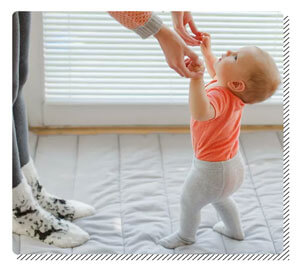
Every child is unique and has different paces of learning baby walking. It is simply not possible to universally conform to a special set of stages that imply a specific set of actions. We believe that your child may be someone who likes to take their time, which means their first steps will have to wait a bit.
It’s unrealistic to expect that your child will be at the same level of mobility as another. Be patient during this process, and celebrate every achievement the same way – regardless of if it occurs on time or later.
2. Encourage every achievement
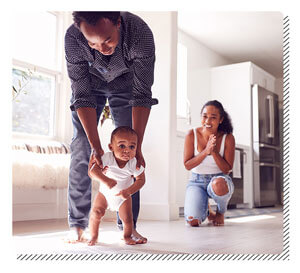
This step is something that you need to remember for the rest of your parenting journey. Psychologically, praises, encouragements, and rewards go a long way in your child’s mental development. If it is expressed to them that certain behavior is desirable, they will try their best to do it over and over again.
This applies when they’re learning to walk as well – clapping and expressing enjoyment at your baby’s attempts will make it clear to them that this is desirable behavior, in which case they’ll display it more often.
3. Be there at every fall
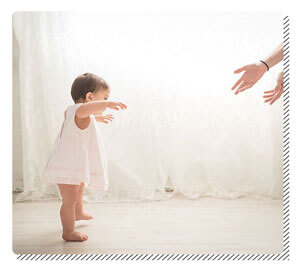
To your child, the best thing that you can do is “to be there.” For each one of their developmental milestones, make sure that you try your best to be present when they succeed or fail.
While walking, it is natural that the process will be filled with stumbles, falls, bumps, and other such minor mishaps. Stick around to comfort your child and encourage them to keep trying, so that your child does not give up and become disenchanted with the idea of walking.
4. Extend your hands towards them

Even with the linguistic barrier between you and your baby, your body language goes a long way in communicating to them what you want them to do. Outstretching your hands towards them is one such gesture. This will tell your kid that you want them to move towards you, and they will immediately scramble to do so.
You can also keep yourself moving backward while extending your hands, subconsciously telling them that they need to walk a longer distance to reach you.
5. Go barefoot
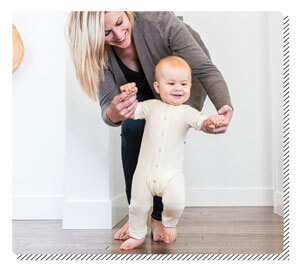
A lot of baby shoes provide maximum ankle support. Which may be desirable in some circumstances, but not so much when your baby is learning to walk at home. It’s best to let them go barefoot – this helps them develop muscle tone and supports the arch of their heel. This also trains them in building a healthy sense of balance – something that cannot be achieved if they’re depending too much on their new pair of kicks.
6. Allow your Baby to Cruise on Furniture

As we explained before, cruising is a phenomenon that involves your child grabbing onto whatever piece of furniture or object, or even the wall to begin walking. This is only a few steps away from walking without any assistance, so you need to pay special attention to this stage. It should be encouraged for them to cruise on furniture, as this strengthens their motor abilities and helps them come to terms with their sense of balance. This would also require you to baby-proof the house securely so that your little one is not holding on to anything that is precariously placed.
7. Get a push toy or a Walker
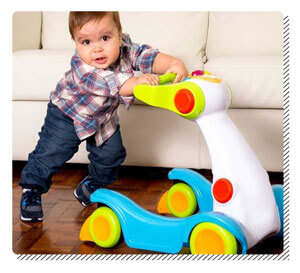
While there are many mixed opinions about introducing your child to a push toy or a walker, chances are that they might be beneficial to individual movement in your child.
However, walkers can be dangerous and are quite prone to accidents. In some cases, they may even hamper motor development in your child. There have been many accidents caused by walkers, so you should be around if your child is in one. Additionally, it is important to limit walker usage every day.
What if the Baby isn’t walking by 15 months?
If your child is a late-bloomer and has not started to cautiously take their first steps around the house by the time they’re 15 months old, it is usually not a cause for worry. It is recommended to wait around 18 months before you take them to the pediatrician, however. Late walking in babies can (very rarely) be a sign of muscle-related complications, so it is best to reassure yourself against it. Mostly, children may prefer taking their time getting around to walking, since the process requires a lot of time and effort for them.
Our Advice
The one big thing that parenting is all about is patience. You need to kick back and let your child run their course of walking independently. Helicoptering or interfering, despite it being out of sheer concern, will only prove to be counterproductive for your child’s development. If you begin to assist them in a way that doesn’t come in the way of their independent learning process, you have nothing to worry about – your child will be and running in no time! Just remember to get it on video because this is one of the most important milestones of your child’s life, and you definitely want to relive it over and over.

Laura is a trained primary teacher who takes a profound liking in interacting with and bringing out the best in children. She is also an ISSA certified pediatrician with an extensive practice of over 12 years. Laura comprehends the needs of infants and now compresses her expertise into writing thorough parenting guides to aid new parents.


